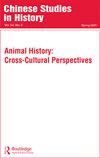Regional interactions in the Chan Buddhist literature between Sichuan and Zhejiang in the Northern and Southern Song periods—Centering on the phenomena of “Sichuan Monks as Laju” and “Zhejiang Monks as Xiaosa”
IF 0.2
4区 历史学
0 ASIAN STUDIES
引用次数: 0
Abstract
Abstract In the history of Chan Buddhism, a special phenomenon emerged during the Song dynasty, wherein many Chan monks from Sichuan traveled downstream to the middle and lower reaches of the Yangzi River. Particularly during the Southern Song, Sichuan monks who went to Zhejiang enjoyed preeminent social status and brought political influence, giving rise to a situation in which Sichuan monks and Zhejiang monks were labeled as laju (“indecorous”) and xiaosa (‘unconstrained’), respectively, in Chan literature. From the perspective of regional literary interactions, the “indecorous” Sichuan monks were chiefly presented as having a fondness for beauty, curiosity, comedy, and humor, with a deep understanding of the nature of knowledge and language, all of which had an important influence on Zhejiang monks. The “unconstrained” Zhejiang monks, on the other hand, were described as having a fondness for using the word qing (“clear, pure”) or a “clear” style in the Buddhist landscape theme poetry, which likewise had a profound influence on Sichuan monks after their arrival in Zhejiang. Therefore, it was in the Southern Song capital Hangzhou in Zhejiang, where a new stage was set for literary interactions between Sichuan and Zhejiang monks in the Northern and Southern Song periods.南宋时期川浙禅宗文学的地域互动——以“川僧为拉居”和“浙僧为小萨”现象为中心
在禅宗的历史上,宋代出现了一个特殊的现象,许多四川的禅宗僧人顺流而下,来到长江中下游。特别是在南宋时期,四川出家浙江的僧人享有优越的社会地位和政治影响力,在禅宗文学中,四川和尚和浙江和尚分别被称为“不守规矩”和“不守规矩”。从地域文学互动的角度看,“不雅”的四川僧人主要表现为爱美、好奇、喜剧、幽默,对知识和语言的本质有着深刻的理解,这些都对浙江僧人产生了重要影响。另一方面,“无拘无束”的浙江僧人,在佛教山水主题诗中被描述为喜欢使用“清”字(“清,纯净”)或“清”字,这同样对四川僧人到达浙江后产生了深远的影响。因此,正是在南宋都城浙江杭州,为北宋和南宋时期四川和浙江僧人之间的文学交流奠定了一个新的舞台。
本文章由计算机程序翻译,如有差异,请以英文原文为准。
求助全文
约1分钟内获得全文
求助全文
来源期刊

CHINESE STUDIES IN HISTORY
Multiple-
CiteScore
0.20
自引率
0.00%
发文量
5
期刊介绍:
Chinese Studies in History makes noteworthy works and important trends of historical study in the Chinese-speaking world available to English-language readers. Thematic issues present original papers or articles from academic journals and anthologies that have been selected for translation because of their excellence, interest, and contribution to scholarship on the topic. Topical coverage ranges over all periods and subfields of Chinese and East Asian history as well as more general theoretical and historiographical questions of interest to historians of many specialties. Each issue includes a substantive introduction by the editor or specialist guest editor.
 求助内容:
求助内容: 应助结果提醒方式:
应助结果提醒方式:


